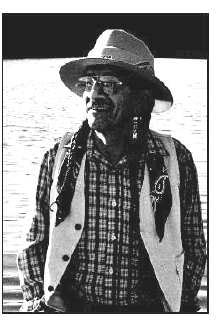|
Un Guerrero de la Cultura |
 |
|
by Jonathan Woytek
Ah yes, October 12th, that glorious day when banks close, the mail stops, and the kiddies get a break from school to commemorate 504 years of genocide, oppression, and cultural castration. From the tundra of Alaska to the paradise of Hawaii, from the plains of the Dakotas to the Rio Grande valley, from East Los to the East Coast there is reason to celebrate. That reason is, despite hundreds of years of "melting people into the pot," of pouring them into the mold of americana, shreds and fragments of indigenous cultures have survived, even flourished, in each of the aforementioned regions. Probably the best example of such endurance is Chicano culture, which blankets the great southwest, and is pocketed in cities and towns throughout the country. It encompasses elements from the Aztecs to the Apaches, its language a mix of Spanish, English, and regional dialects, and its people have passed it on to their children through customs, comida, and pride. Immense pride.
With the publication of his third volume of poetry, East of the Freeway, Austin's own hijo, the self-proclaimed "cockroach poet," Raul Salinas, returns to the barrios of his youth in 53 poems spanning three decades, to leave a powerful testament to the struggles
For those who are unfamiliar with Raul Salinas, the man is quite simply a dynamo in the ongoing battle against socio-economic injustice. Along with owning and operating La Resistencia Bookstore and Red Salmon Press, he has served as an advisor for street-gang peace treaties, worked extensively with the American Indian Movement and the Prisoner's Rights Support Network, and just recently returned from Mexico City, where he marched as a delegate of the National Indigenous Congress in protest of events in Chiapas, Mexico. He has survived the federal penitentiary and the pitfalls of the streets to become an internationally known voice for the cause of equity.
For those unfamiliar with Raul Salinas, the poet, he is stylistically one of the most perceptive, unsung beat poets I have ever read. His work ebbs and flows, like cool jazz from a late night dive. He is masterful in the use of double connotation and selective capitalization as tools of expression, but the profundity of his writing sets him apart from most other beat poets. A good example of this can be found in the poem "On the Police Murder of Jonathan Rodney" :
Dead peoples who are Black' n' Brown
In other poems such as "Riff(t)s" and "Shame on the Shaman," Salinas not only maintains the unconventional meter associated with Beat poetry, but he addresses the differences between himself and beat icons Kerouac and Ginsberg with insight and wit. Where as the latter two were concerned with individual freedoms, Salinas, in the tradition of the great Pablo Neruda, is concerned with la libertad de la gente.
Salinas shows the diversity of his skills when he strays from beat and writes in more traditional formats. The poem "A Fantasy of Southtown Streets (an excuse for a love poem)," is an impressive example of descriptive verse, reminiscent of Roethke's work. It is also textbook in its use of alliteration. "About Invasion and Conquest" utilizes a more conventional meter to set a somber tone against which the poet paints a painful(but true) portrait of the plundering of the Americas. Other poems in which Salinas tackles events of historical significance are "Remember Vietnam?" and "Solidarite," recounting the horrors of war and its survivors, and giving a glimpse of the compassion the poet feels for all people.
Still, when Salinas takes the reader to the streets of the barrios, he is at his very best. In "Pueblo Querido" he contrasts his memories of his youth with the variables of his incarceration, and while the poem ends with a sense of melancholy, there are no regrets. He addresses the violence of survival in "Letter to Lefty" and "Al Fin Llegaron las Lluvias" and the hardships endured by Chicanas in "Homenaje a la Pachuca (Blues for Blood)" :
SuperWoman
Throughout East of the Freeway, Salinas remains a realist in the purest sense, yet even among the brutal imagery of "A Walk Through the Campo Santo," or the good ol' boy bigotry of "Rememorings," that realism maintains hope, and sus recuerdos are all written of with a wistful fondness. While the poems comprising this volume are of a reflective nature, their images ultimately create a bridge to the future for all who face day to day survival in the barrio.
Symbolic is the fact that the poet doesn't capitalize his name, spelling it "raul r. salinas," saying something about a man who is more concerned with the respect of his people, than with his own recognition. He feeds off of the historical legacy of brutality and oppression against indigenous people everywhere, drawing the strength and inspiration he needs not only for his poetry, but for his tireless pursuit of justice. Poet, wise man, y soldado, Salinas not only continues to preserve his heritage, but he is a torchbearer, lighting the path for his culture to follow into the 21st Century.
|
||
top | this issue | ADA home |
||
 and pride of his people. The majority of the poems are written in English, intertwined with regional Spanish and street slang, and it is through this unique voice that the poet serves as an activist and scribe in the resistance against conformity.
and pride of his people. The majority of the poems are written in English, intertwined with regional Spanish and street slang, and it is through this unique voice that the poet serves as an activist and scribe in the resistance against conformity.